|
|
#661 |
|
⊙▃⊙
|
What's in the sky tonight?
September 4, 2013 -The big but dark-colored asteroid 324 Bamberga has brightened to magnitude 8.3. It's nearly at an unusually close, once-in-22-years opposition. Seek it out on the edge of the Circlet of Pisces. -Venus (magnitude –4.0) shines brightly low in the west in evening twilight, far below Arcturus. Look a little to its left for much fainter Spica early in the week, then watch Venus close in on Spica every day. It passes less than 2° above Spica on September 5th. Binoculars help. Look too for Saturn about 14° upper left of Spica. -All of the sunspots on the Earthside of the sun are stable and quiet. NOAA forecasters estimate a slight 5% chance of M-class solar flares and no more than a 1% chance of X-class flares on Sept. 4th. Astro Picture of the Day: September 4, 2013  Will this caterpillar-shaped interstellar cloud one day evolve into a butterfly-shaped nebula? No one is sure. What is sure is that IRAS 20324+4057, on the inside, is contracting to form a new star. On the outside, however, energetic winds are blowing and energetic light is eroding away much of the gas and dust that might have been used to form the star. Therefore, no one is sure what mass the resulting star will have, and, therefore, no one knows the fate of this star. Were the winds and light to whittle the protostar down near the mass of the Sun, the outer atmosphere of this new star may one day expand into a planetary nebula, possibly even one that looks like a butterfly. Alternatively, if the stellar cocoon retains enough mass, a massive star will form that will one day explode in a supernova. The eroding protostellar nebula IRAS 20324+4057 spans about one light year and lies about 4,500 light years away toward the constellation of the Swan (Cygnus). The above image of IRAS 20324+4057 was taken with the Hubble Space Telescope in 2006 but released last week. The battle between gravity and light will likely take over 100,000 years to play out, but clever observations and deductions may yet yield telling clues well before that.
__________________
1st in Kommisar's 2009 SM Tournament 1st in I Love You`s 2009 New Year`s Tournament 3rd in EnR's Mashfest '08 tournament 5th in Phynx's Unofficial FFR Tournament 9th in D3 of the 2008-2009 4th Official FFR Tournament 10th in D5 of the 2010 5th Official FFR Tournament 10th in D6 of the 2011-2012 6th Official FFR Tournament FMO AAA Count: 71 FGO AAA Count: 10 Bluearrowll = The Canadian player who can not detect awkward patterns. If it's awkward for most people, it's normal for Terry. If the file is difficult but super straight forward, he has issues. If he's AAAing a FGO but then heard that his favorite Hockey team was losing by a point, Hockey > FFR PS: Cool AAA's Terry - I Love You An Alarm Clock's Haiku beep beep beep beep beep beep beep beep beep beep beep beep beep beep beep beep beep - ieatyourlvllol |
|
|

|
|
|
#662 |
|
⊙▃⊙
|
What's in the sky tonight?
September 5, 2013 -As evening twilight fades, spot Venus low in the west. Look below it (by less than 2°) for much fainter little Spica twinkling away. Binoculars help. Saturn glows 14° to their upper left. -Twice every year, around the time of the equinoxes, Earth can pass directly between the Sun and NASA's Solar Dynamics Observatory (SDO), producing a series of beautiful eclipses from the point of view of the spacecraft. SDO's autumnal eclipse season began this week, producing a partial blackout of the sun. During the eclipse, which was centered around 0658 UT on Sept. 2nd, Earth covered about half of the sun. Because these eclipses typically last for only minutes each day (maximum=72 minutes), there is still plenty of uninterrupted time for SDO to monitor activity on the sun. The ongoing eclipse season will end on Sept. 25th. Below is a youtube video and a picture of such eclipses. 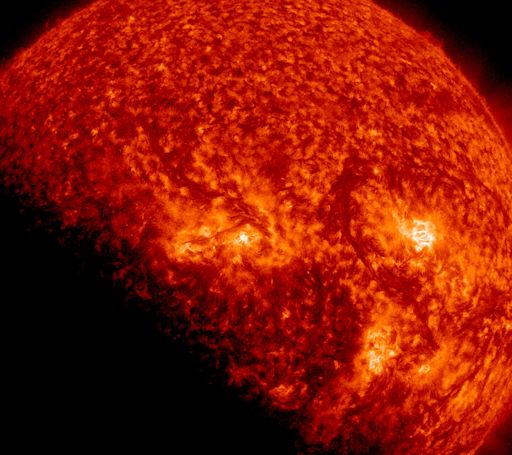 Astro Picture of the Day: September 5, 2013  The Crab Nebula is cataloged as M1, the first on Charles Messier's famous list of things which are not comets. In fact, the Crab is now known to be a supernova remnant, an expanding cloud of debris from the explosion of a massive star. The violent birth of the Crab was witnessed by astronomers in the year 1054. Roughly 10 light-years across today, the nebula is still expanding at a rate of over 1,000 kilometers per second. Want to see the Crab Nebula expand? Compare an image of M1 taken in 1999 at the European Southern Observatory, with this one, taken in 2012 at the Mt. Lemmon Sky Center. Background stars were used to register the two images. The Crab Nebula lies about 6,500 light-years away in the constellation Taurus. The 1999 image is found below. Look closely at the stars to either side of the Crab Nebula on both pictures. http://www.eso.org/public/images/eso9948f/
__________________
1st in Kommisar's 2009 SM Tournament 1st in I Love You`s 2009 New Year`s Tournament 3rd in EnR's Mashfest '08 tournament 5th in Phynx's Unofficial FFR Tournament 9th in D3 of the 2008-2009 4th Official FFR Tournament 10th in D5 of the 2010 5th Official FFR Tournament 10th in D6 of the 2011-2012 6th Official FFR Tournament FMO AAA Count: 71 FGO AAA Count: 10 Bluearrowll = The Canadian player who can not detect awkward patterns. If it's awkward for most people, it's normal for Terry. If the file is difficult but super straight forward, he has issues. If he's AAAing a FGO but then heard that his favorite Hockey team was losing by a point, Hockey > FFR PS: Cool AAA's Terry - I Love You An Alarm Clock's Haiku beep beep beep beep beep beep beep beep beep beep beep beep beep beep beep beep beep - ieatyourlvllol |
|
|

|
|
|
#663 |
|
FFR Player
|
The universe is pretty amazing.
|
|
|

|
|
|
#664 |
|
⊙▃⊙
|
What's in the sky tonight?
September 6, 2013 -If you live on the East coast of the US, stay up tonight to witness the rocket plume of a satellite launching into the skies. In most locations, the ascending rocket won't climb more than 10° to 15° above the horizon by the time the third stage shuts down, as the first map below shows. You will need a flat horizon for the event. If you are unable to witness the event for yourself, there is a live stream found here: http://www.nasa.gov/multimedia/nasatv/index.html -The second map below indicates when you can expect the rocket to be visible in your area.The targeted launch window on September 6, 2013 is from 11:27 - 11:31 PM EDT. -As evening twilight fades, spot Venus low in the west. Look below it by 2° for little Spica twinkling much fainter. Binoculars help. Saturn glows 13° to Venus's upper left.   News Posted Today: September 5, 2013 LADEE Leaves for Luna  Astro Picture of the Day: September 6, 2013 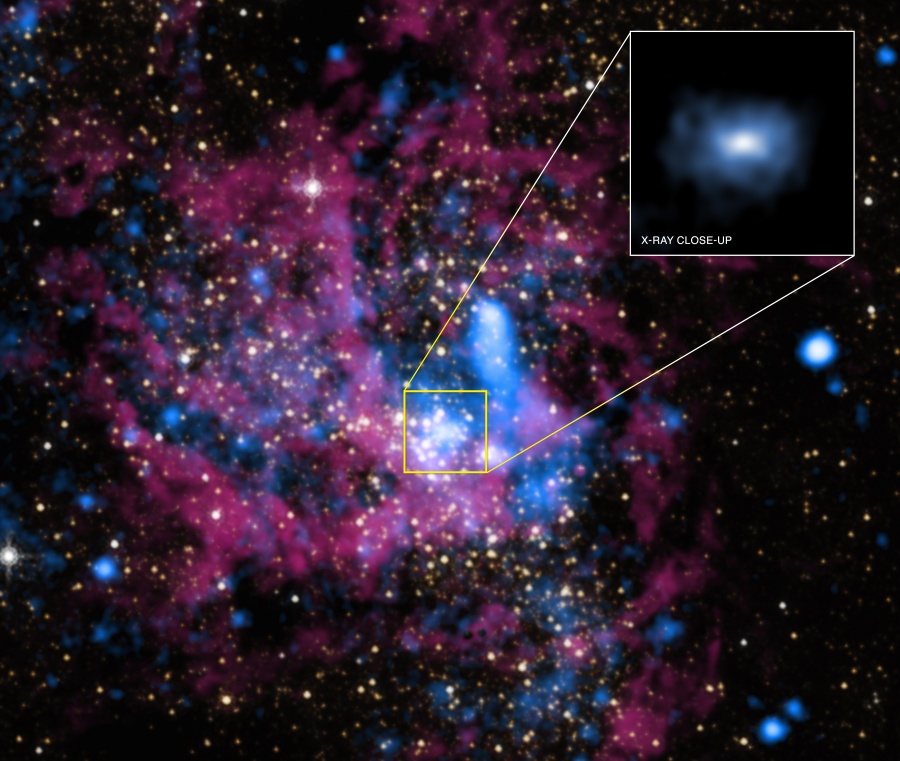 Hot gas is hard to swallow. At least that seems to be true for the supermassive black hole at the center of our Milky Way Galaxy. Known as source Sagittarius A*, the Milky Way's black hole is centered in this infrared (red and yellow hues) and X-ray (blue) composite. Based on data from an extensive campaign of observations by the orbiting Chandra X-ray telescope, the diffuse emission surrounding the black hole is seen in the close-up inset, the inset field spanning about 1/2 light-year across the galactic center some 26,000 light-years away. Astronomers have found that the X-ray emission originates in hot gas drawn from the winds of massive young stars in the region. The Chandra data indicate that only about 1% or less of the gas within the black hole's gravitational influence ever reaches the event horizon, losing enough heat and angular momentum to fall into the black hole, while the rest of the gas escapes in an outflow. The result explains why the Milky Way's black hole is so quiet, much fainter than might be expected in energetic X-rays. It likely holds for most supermassive black holes in galaxies in the nearby Universe. The Chandra X-Ray Observatory has a supplemental explanation found here: http://chandra.harvard.edu/blog/node/452
__________________
1st in Kommisar's 2009 SM Tournament 1st in I Love You`s 2009 New Year`s Tournament 3rd in EnR's Mashfest '08 tournament 5th in Phynx's Unofficial FFR Tournament 9th in D3 of the 2008-2009 4th Official FFR Tournament 10th in D5 of the 2010 5th Official FFR Tournament 10th in D6 of the 2011-2012 6th Official FFR Tournament FMO AAA Count: 71 FGO AAA Count: 10 Bluearrowll = The Canadian player who can not detect awkward patterns. If it's awkward for most people, it's normal for Terry. If the file is difficult but super straight forward, he has issues. If he's AAAing a FGO but then heard that his favorite Hockey team was losing by a point, Hockey > FFR PS: Cool AAA's Terry - I Love You An Alarm Clock's Haiku beep beep beep beep beep beep beep beep beep beep beep beep beep beep beep beep beep - ieatyourlvllol |
|
|

|
|
|
#665 |
|
⊙▃⊙
|
What's in the sky tonight?
September 7, 2013 - While twilight is still bright, use binoculars to look for the thin crescent Moon just above the western horizon to the lower right of Venus and Spica, as shown here. -Low before dawn, Mars passes through the Beehive star cluster Sunday and Monday mornings. -NASA's LADEE spacecraft is headed toward the Moon after launching on a Minataur V rocket Friday night from NASA's Wallops Flight Facility in Virginia. The launch, which occured at 11:27 pm EDT, was widely visible along the US east coast from Maine to the Carolinas. Ben Cooper on took the below picture of the rocket flying over the Empire State Building in New York. -"As seen from the Top of Rockefeller Center, LADEE launches to the moon aboard Orbital Sciences Minotaur V rocket," says Cooper. "[It soared] over the blue-and-green Empire State Building, lit for the US Open of tennis." -The launch kicks off LADEE's mission to investigate the Moon's atmosphere. Yes, the "airless Moon" has an atmosphere. It is ten thousand billion times thinner than Earth's, but nevertheless there. Apollo astronauts actually saw it with their own eyes. -LADEE, short for "Lunar Atmosphere and Dust Environment Explorer," will circle the Moon for 100 days to assay the lunar atmosphere. Instruments onboard the spacecraft will look for signs of humidity, electrified dust, and atoms hopping across the lunar surface. A NASA video about LADEE previews the mission. 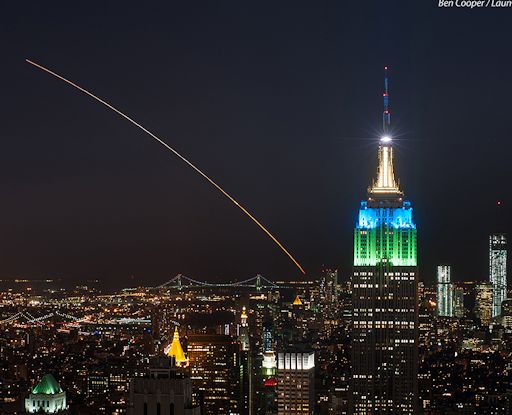 Astro Picture of the Day: September 7, 2013   This forest of snow and ice penitentes reflects moonlight shinning across the Chajnantor plateau. The region lies in the Chilean Andes at an altitude of 5,000 meters, not far from one of planet Earth's major astronomical observatories, the Atacama Large Millimeter/submillimeter Array. Up to several meters high, the flattened, sharp-edged shapes, and orientation of the penitentes tend to minimize their shadows at local noon. In the dry, cold, thin atmosphere, sublimation driven by sunlight is important for their formation. A direct transition from a solid to a gaseous state, sublimation shapes other solar system terrains too, like icy surfaces of comets and the polar caps of Mars. Above the dreamlike landscape stretches the southern night sky. Their own forms rooted in myth, look for the constellations Pegasus, Andromeda, and Perseus near the panorama's left edge. Bright and colorful stars of Orion the Hunter are near center, with the Large Magellanic Cloud and the South Celestial Pole on the far right.
__________________
1st in Kommisar's 2009 SM Tournament 1st in I Love You`s 2009 New Year`s Tournament 3rd in EnR's Mashfest '08 tournament 5th in Phynx's Unofficial FFR Tournament 9th in D3 of the 2008-2009 4th Official FFR Tournament 10th in D5 of the 2010 5th Official FFR Tournament 10th in D6 of the 2011-2012 6th Official FFR Tournament FMO AAA Count: 71 FGO AAA Count: 10 Bluearrowll = The Canadian player who can not detect awkward patterns. If it's awkward for most people, it's normal for Terry. If the file is difficult but super straight forward, he has issues. If he's AAAing a FGO but then heard that his favorite Hockey team was losing by a point, Hockey > FFR PS: Cool AAA's Terry - I Love You An Alarm Clock's Haiku beep beep beep beep beep beep beep beep beep beep beep beep beep beep beep beep beep - ieatyourlvllol |
|
|

|
|
|
#666 |
|
⊙▃⊙
|
What's in the sky tonight?
September 8, 2013 -When the sun goes down tonight, step outside and look west. Venus and the slender crescent Moon are gathering in the twilight sky for a beautiful conjunction. Sky watchers across North America will see them only 1o to 3o degrees apart, while observers in far-South America will witness a full-fledged occultation. The Moon will pass directly in front of Venus. It's a nice way to end the day.  Astro Picture of the Day: September 8, 2013 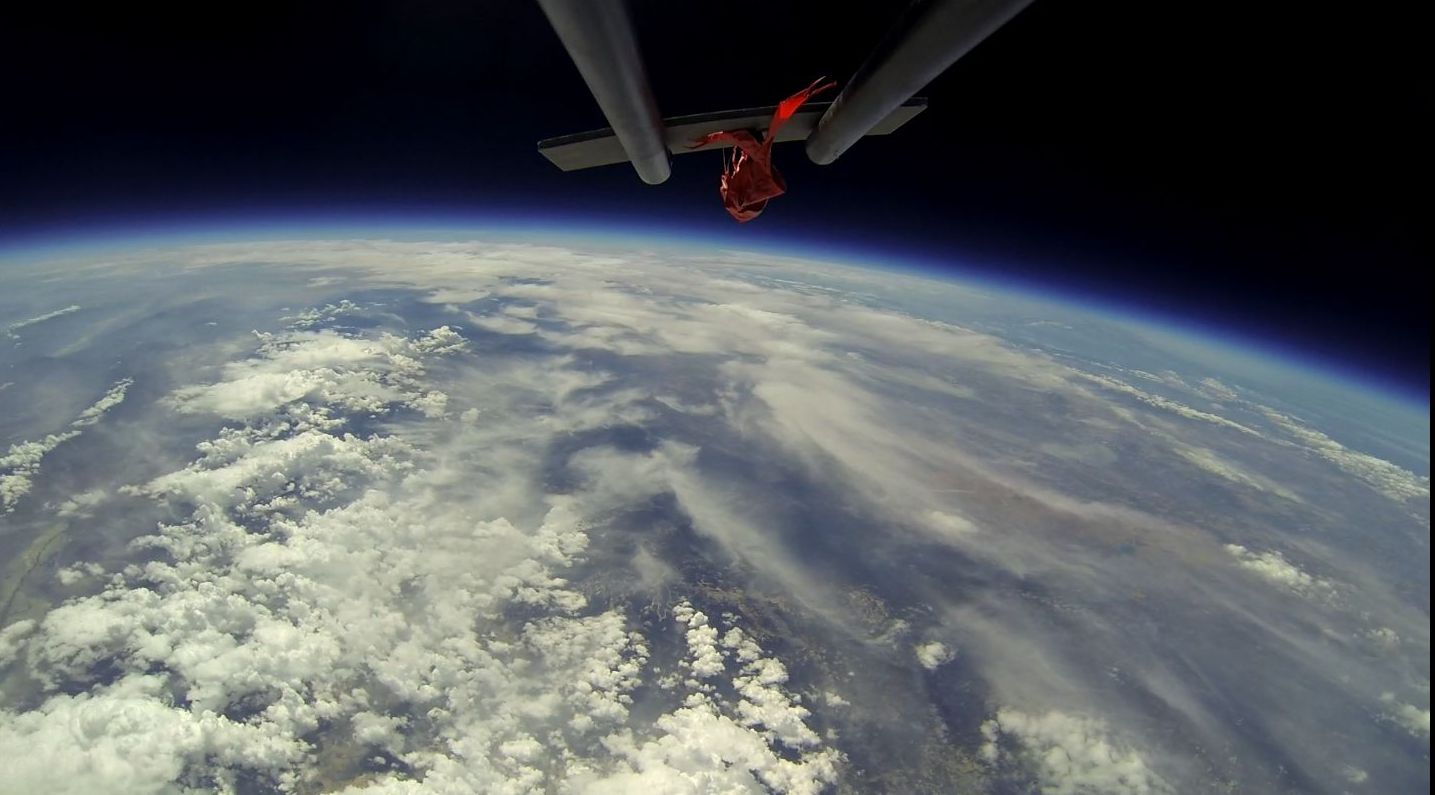 The Rim Fire overlapping Yosemite National Park has now burned more than a quarter of a million acres (390 sq. miles), and according to the US Forest Service it may continue to grow, thanks to low humidity and other conditions. Smoke from the wildfire is affecting an even greater area. On Sept. 1st, the students of Earth to Sky Calculus sent a camera to the edge of space for a wide-angle shot of the smokey plumes. This photo, which was taken from the payload of a helium balloon 110,000 feet above Earth's surface, captures more than 10,000 sq. miles of terrain. About half is covered with filaments of smoke from the Rim Fire. There is far more smoke in the image than cumulus clouds. In recent weeks, shifting wind patterns have drawn the plumes back and forth across the mountain towns of the eastern Sierra Nevada, prompting frequent air quality warnings in some places. This photo shows that helium balloons can be effective tools for monitoring the location of the smoke. The black bars and popped red balloon jutting into the top of the photo are part of another ongoing experiment. The students have been dispersing small amounts of powder and ash into the stratosphere to measure the "hang time" of tiny particles. The particles ascend inside a small balloon, which pops at altitude to scatter its contents at the edge of space. As NASA studies of an exploding asteroid over Russia have confirmed, fine ash deposited in the stratosphere does not immediately fall to the ground. It circles the globe for months or more, usually landing harmlessly in remote ocean areas.
__________________
1st in Kommisar's 2009 SM Tournament 1st in I Love You`s 2009 New Year`s Tournament 3rd in EnR's Mashfest '08 tournament 5th in Phynx's Unofficial FFR Tournament 9th in D3 of the 2008-2009 4th Official FFR Tournament 10th in D5 of the 2010 5th Official FFR Tournament 10th in D6 of the 2011-2012 6th Official FFR Tournament FMO AAA Count: 71 FGO AAA Count: 10 Bluearrowll = The Canadian player who can not detect awkward patterns. If it's awkward for most people, it's normal for Terry. If the file is difficult but super straight forward, he has issues. If he's AAAing a FGO but then heard that his favorite Hockey team was losing by a point, Hockey > FFR PS: Cool AAA's Terry - I Love You An Alarm Clock's Haiku beep beep beep beep beep beep beep beep beep beep beep beep beep beep beep beep beep - ieatyourlvllol |
|
|

|
|
|
#667 |
|
⊙▃⊙
|
What's in the sky tonight?
September 9, 2013 -This evening the Moon in twilight stands off farther left of Saturn, with Venus down to their lower right. -The face of the sun is nearly blank. There are only two tiny sunspots and neither one is flaring. NOAA forecasters estimate no more than a 1% chance of M- or X-class flares during the next 24 hours. -Last night, sky watchers in Europe and the Americas witnessed a beautiful conjunction of Venus and the crescent Moon. At closest approach, the two brightest objects in the night sky were less than 1 degree apart. In case you missed it, a similar conjunction will next place next month on Oct. 7-8.  Astro Picture of the Day: September 9, 2013 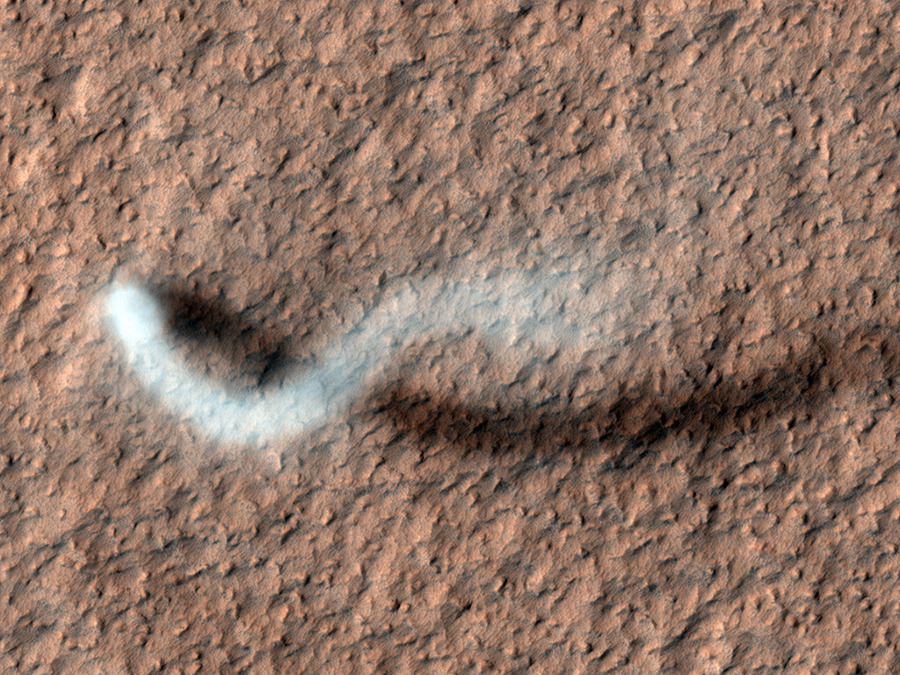 It was late in the northern martian spring when the HiRISE camera onboard the Mars Reconnaissance Orbiter spied this local denizen. Tracking south and east (down and right) across the flat, dust-covered Amazonis Planitia the core of the whirling dust devil is about 30 meters in diameter. Lofting dust into the thin martian atmosphere, its plume reaches more than 800 meters above the surface. Not following the path of the dust devil, the plume is blown toward the east by a westerly breeze. Common in this region, dust devils occur as the surface is heated by the Sun, generating warm, rising air currents that begin to rotate. Tangential wind speeds of up to 110 kilometers per hour are reported for dust devils in other HiRISE images.
__________________
1st in Kommisar's 2009 SM Tournament 1st in I Love You`s 2009 New Year`s Tournament 3rd in EnR's Mashfest '08 tournament 5th in Phynx's Unofficial FFR Tournament 9th in D3 of the 2008-2009 4th Official FFR Tournament 10th in D5 of the 2010 5th Official FFR Tournament 10th in D6 of the 2011-2012 6th Official FFR Tournament FMO AAA Count: 71 FGO AAA Count: 10 Bluearrowll = The Canadian player who can not detect awkward patterns. If it's awkward for most people, it's normal for Terry. If the file is difficult but super straight forward, he has issues. If he's AAAing a FGO but then heard that his favorite Hockey team was losing by a point, Hockey > FFR PS: Cool AAA's Terry - I Love You An Alarm Clock's Haiku beep beep beep beep beep beep beep beep beep beep beep beep beep beep beep beep beep - ieatyourlvllol |
|
|

|
|
|
#668 |
|
⊙▃⊙
|
What's in the sky tonight?
September 10, 2013 -Venus and Saturn (magnitudes –4.1 and +0.7, respectively) hang low in the west-southwest in evening twilight, far lower left of Arcturus. Venus is the brightest but lowest. Saturn glimmers to Venus's upper left, a little closer every day. The star Spica begins the week just under Venus, then moves away to its lower right. Bring binoculars to help with Saturn and Spica. Astro Picture of the Day: September 10, 2013  It is one of the most important stars in the sky. This is partly because, by coincidence, it is surrounded by a dazzling reflection nebula. Pulsating RS Puppis, the brightest star in the image center, is some ten times more massive than our Sun and on average 15,000 times more luminous. In fact, RS Pup is a Cepheid type variable star, a class of stars whose brightness is used to estimate distances to nearby galaxies as one of the first steps in establishing the cosmic distance scale. As RS Pup pulsates over a period of about 40 days, its regular changes in brightness are also seen along the nebula delayed in time, effectively a light echo. Using measurements of the time delay and angular size of the nebula, the known speed of light allows astronomers to geometrically determine the distance to RS Pup to be 6,500 light-years, with a remarkably small error of plus or minus 90 light-years. An impressive achievement for stellar astronomy, the echo-measured distance also more accurately establishes the true brightness of RS Pup, and by extension other Cepheid stars, improving the knowledge of distances to galaxies beyond the Milky Way. The above image was taken by the Hubble Space Telescope and digitally processed by a volunteer.
__________________
1st in Kommisar's 2009 SM Tournament 1st in I Love You`s 2009 New Year`s Tournament 3rd in EnR's Mashfest '08 tournament 5th in Phynx's Unofficial FFR Tournament 9th in D3 of the 2008-2009 4th Official FFR Tournament 10th in D5 of the 2010 5th Official FFR Tournament 10th in D6 of the 2011-2012 6th Official FFR Tournament FMO AAA Count: 71 FGO AAA Count: 10 Bluearrowll = The Canadian player who can not detect awkward patterns. If it's awkward for most people, it's normal for Terry. If the file is difficult but super straight forward, he has issues. If he's AAAing a FGO but then heard that his favorite Hockey team was losing by a point, Hockey > FFR PS: Cool AAA's Terry - I Love You An Alarm Clock's Haiku beep beep beep beep beep beep beep beep beep beep beep beep beep beep beep beep beep - ieatyourlvllol |
|
|

|
|
|
#669 |
|
⊙▃⊙
|
What's in the sky tonight?
September 11, 2013 -Altair is the brightest star shining high in the south these evenings. Look a finger-width at arm's length to its upper right for fainter Tarazed, a red giant far in Altair's background. Look a little more than a fist to Altair's left or upper left for Delphinus, the leaping Dolphin. -Sometimes, Earth mimics a supernova, producing a Terrestrial Gamma-ray Flash from the tops of thunderstorms. A new lightning sensor on the International Space Station could solve the mystery of these energetic bursts. http://science.nasa.gov/science-news...p_firestation/ Astro Picture of the Day: September 11, 2013 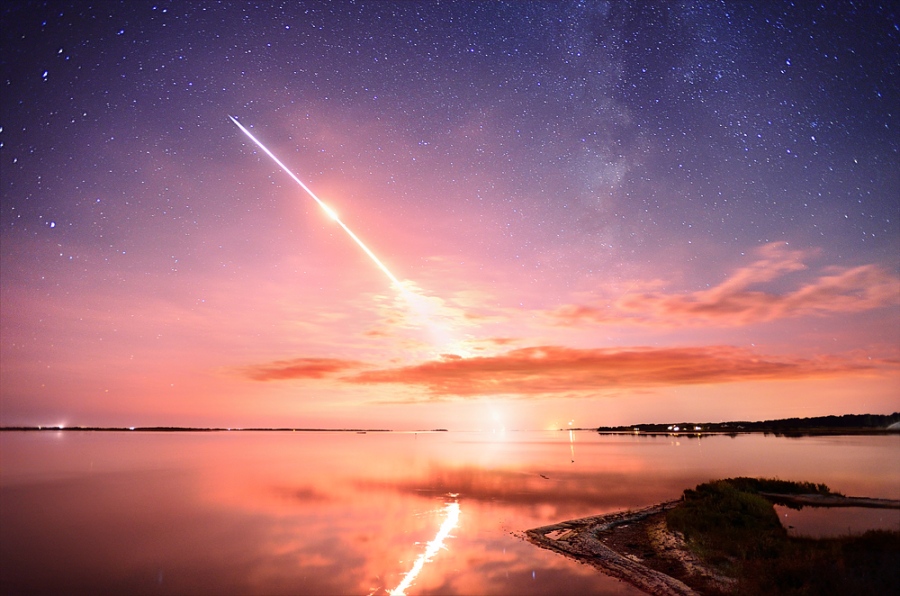 On September 6, a starry night and the Milky Way witnessed the launch of a Minotaur V rocket from NASA's Wallops Flight Facility on Wallops Island, Virginia. So did a large part of the eastern United States, as the spectacular night launch was easily visible even from light polluted urban areas. This 35 second exposure captures part of the rocket's initial launch streak and 2nd stage ignition flare along with a brilliant reflection of the fiery sky in calm waters. The stunning view faces south and west from a vantage point overlooking Sinepuxent Bay in Maryland about 20 miles north of the launch pad. Heading east over the Atlantic, the multi-stage rocket placed LADEE, the Lunar Atmosphere and Dust Environment Explorer, into a highly elliptical Earth orbit to begin its journey to the Moon.
__________________
1st in Kommisar's 2009 SM Tournament 1st in I Love You`s 2009 New Year`s Tournament 3rd in EnR's Mashfest '08 tournament 5th in Phynx's Unofficial FFR Tournament 9th in D3 of the 2008-2009 4th Official FFR Tournament 10th in D5 of the 2010 5th Official FFR Tournament 10th in D6 of the 2011-2012 6th Official FFR Tournament FMO AAA Count: 71 FGO AAA Count: 10 Bluearrowll = The Canadian player who can not detect awkward patterns. If it's awkward for most people, it's normal for Terry. If the file is difficult but super straight forward, he has issues. If he's AAAing a FGO but then heard that his favorite Hockey team was losing by a point, Hockey > FFR PS: Cool AAA's Terry - I Love You An Alarm Clock's Haiku beep beep beep beep beep beep beep beep beep beep beep beep beep beep beep beep beep - ieatyourlvllol |
|
|

|
|
|
#670 |
|
⊙▃⊙
|
What's in the sky tonight?
September 12, 2013 -The big but dark-colored asteroid 324 Bamberga is reaching opposition at magnitude 8.1 — an unusually close, once-in-22-years opposition. Seek it out near the Circlet of Pisces. -European sky watchers are reporting an outburst of September epsilon Perseid meteors. "The outburst occurred around UT midnight on Sept. 9-10," says Bill Cooke, head of NASA's Meteoroid Environment Office. "During a two hour period, meteors appeared at a rate equivalent to ~50 per hour (ZHR). We did not see the outburst in North America because it was still daylight at the time." NASA all-sky cameras have been recording epsilon Perseid fireballs for days, albeit at a much lower rate than what the Europeans saw. The shower has been active since early September, allowing Cooke's team to calculate orbits for more than a dozen meteoroids. In the diagram, orbits are color-coded by velocity. Epsilon Perseid meteoroids hit Earth's atmosphere at a "blue-green" speed of about 62 km/s (139,000 mph). According to NASA data, the debris stream appears to be rich in fireball-producing meteoroids. The epsilon Perseid shower peaks every year around this time, but the shower is not well known because it is usually weak, producing no more than 5 meteors per hour. In 2008 the shower surprised observers with an outburst five times as active, and this year the shower may have doubled even that. Clearly, the epsilon Perseid debris stream contains some dense filaments of material that Earth usually misses but sometimes hits. No one knows the source of the September epsilon Perseid meteor shower. Whatever the parent is, probably a comet, its orbit must be similar to the green ellipses shown in the orbit-map above. As NASA cameras continue to gather data on this shower, orbital parameters will become more accurately known, possibly leading to a match. Meanwhile, sky watchers should be alert for more epsilon Perseids in the nights ahead. The shower is waning but still active and more outbursts are possible.  News Posted Today: September 11, 2013 Deep Impact on the Fritz  Astro Picture of the Day: September 12, 2013 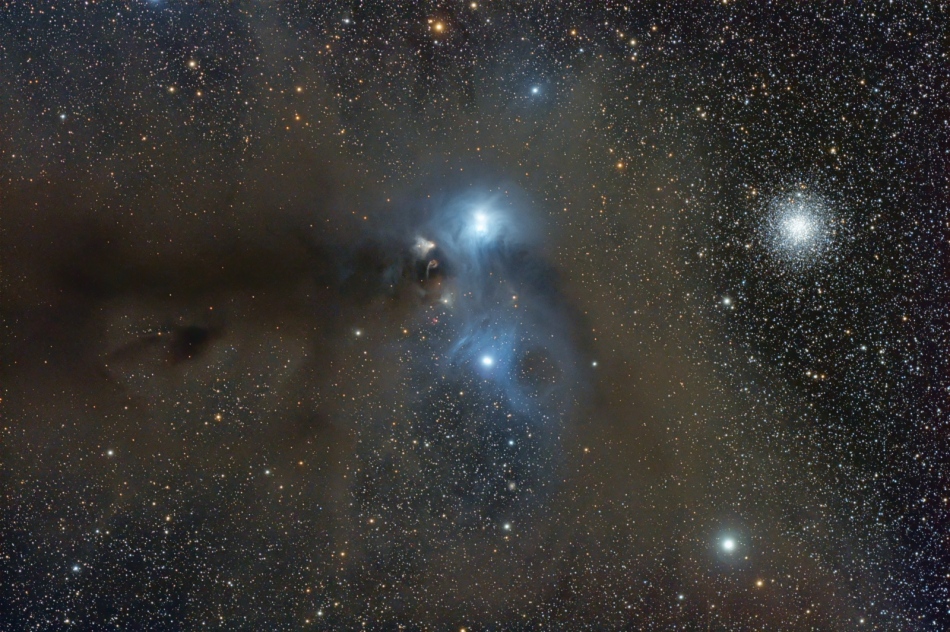 Cosmic dust clouds sprawl across a rich field of stars in this sweeping telescopic vista near the northern boundary of Corona Australis, the Southern Crown. Less than 500 light-years away the dust clouds effectively block light from more distant background stars in the Milky Way. The entire frame spans about 2 degrees or over 15 light-years at the clouds' estimated distance. Near center is a group of lovely reflection nebulae cataloged as NGC 6726, 6727, 6729, and IC 4812. A characteristic blue color is produced as light from hot stars is reflected by the cosmic dust. The dust also obscures from view stars in the region still in the process of formation. Smaller yellowish nebula NGC 6729 surrounds young variable star R Coronae Australis. Below it are arcs and loops identified as Herbig Haro objects associated with energetic newborn stars. Magnificent globular star cluster NGC 6723 is at the right. Though NGC 6723 appears to be part of the group, its ancient stars actually lie nearly 30,000 light-years away, far beyond the young stars of the Corona Australis dust clouds.
__________________
1st in Kommisar's 2009 SM Tournament 1st in I Love You`s 2009 New Year`s Tournament 3rd in EnR's Mashfest '08 tournament 5th in Phynx's Unofficial FFR Tournament 9th in D3 of the 2008-2009 4th Official FFR Tournament 10th in D5 of the 2010 5th Official FFR Tournament 10th in D6 of the 2011-2012 6th Official FFR Tournament FMO AAA Count: 71 FGO AAA Count: 10 Bluearrowll = The Canadian player who can not detect awkward patterns. If it's awkward for most people, it's normal for Terry. If the file is difficult but super straight forward, he has issues. If he's AAAing a FGO but then heard that his favorite Hockey team was losing by a point, Hockey > FFR PS: Cool AAA's Terry - I Love You An Alarm Clock's Haiku beep beep beep beep beep beep beep beep beep beep beep beep beep beep beep beep beep - ieatyourlvllol |
|
|

|
|
|
#671 |
|
⊙▃⊙
|
What's in the sky tonight?
September 13, 2013 -Saturn has closed to within 6° of Venus low in the western twilight, as shown at right. They'll pass 3½° apart on Wednesday and Thursday. -Researchers have long waited for one of the Voyager probes to leave the solar system. In a surprising turn of events, NASA announced today that Voyager 1 entered interstellar space a whole year ago! This event sets in motion a new era of exploration of the realm between the stars. Full story can be found here: http://science.nasa.gov/science-news...2sep_voyager1/ In February 2012, the National Radio Astronomy Observatory's 5,000-mile-wide Very Long Baseline Array (VLBA) made a radio image of Voyager 1's signal. Little did they know, Voyager 1 was already in interstellar space. Voyager 1's main transmitter radiates around 22 watts, which is comparable to a typical ham radio or a refrigerator light bulb. Though incredibly weak by the standards of modern wireless communications, Voyager 1's signal is bright when compared to most natural objects studied by radio telescopes. The image below is about 0.5 arcseconds on a side. An arcsecond is the apparent size of a penny as seen from 2.5 miles (4 kilometers) away. The slightly oblong shape of the image is a result of the array's configuration. The VLBA made this image of Voyager 1's signal on Feb. 21, 2013. At the time, Voyager 1 was 11.5 billion miles (18.5 billion kilometers) away. 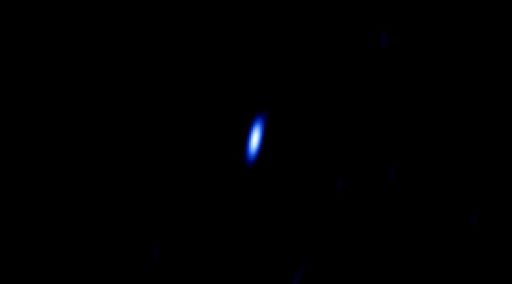  Astro Picture of the Day: September 13, 2013 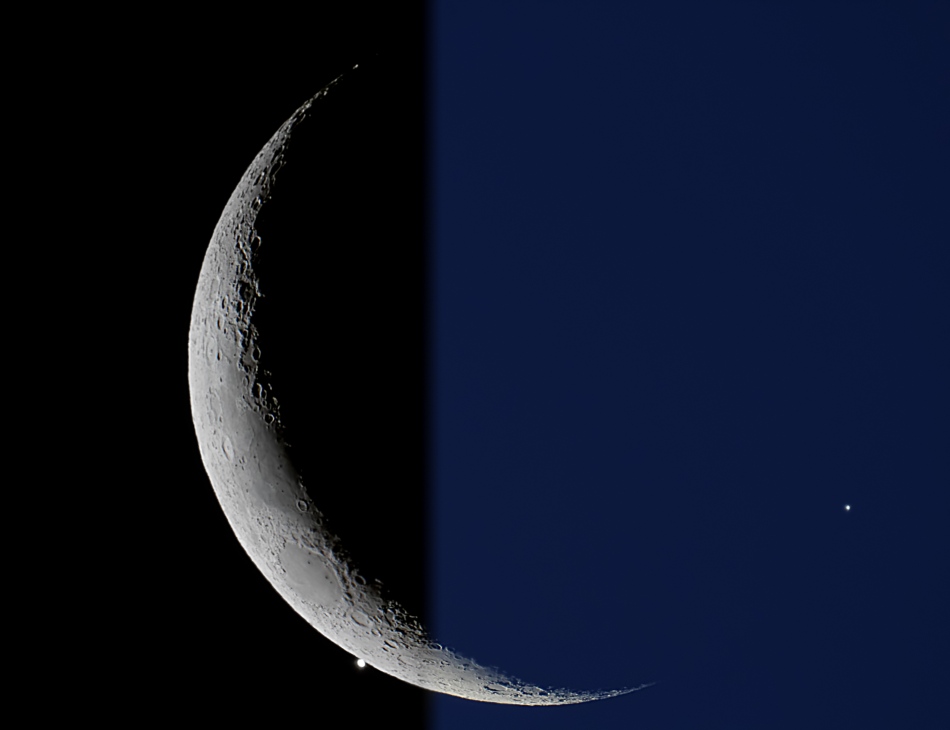 On September 8, brilliant planet Venus appearing as the evening star stood near a slender, crescent Moon at sunset. The close celestial pairing or conjunction was a scene enjoyed by skygazers around the world. But from some locations in South America, the Moon actually passed in front of Venus in a lunar occultation. Captured near Las Cañas, Uruguay, this two frame mosaic telescopic view shows the Moon and Venus before and after the occultation. The silvery evening star appears at right just before it winked out behind the dark lunar limb, still in bright twilight skies. About an hour later Venus emerged (left) along the three day old Moon's sunlit edge.
__________________
1st in Kommisar's 2009 SM Tournament 1st in I Love You`s 2009 New Year`s Tournament 3rd in EnR's Mashfest '08 tournament 5th in Phynx's Unofficial FFR Tournament 9th in D3 of the 2008-2009 4th Official FFR Tournament 10th in D5 of the 2010 5th Official FFR Tournament 10th in D6 of the 2011-2012 6th Official FFR Tournament FMO AAA Count: 71 FGO AAA Count: 10 Bluearrowll = The Canadian player who can not detect awkward patterns. If it's awkward for most people, it's normal for Terry. If the file is difficult but super straight forward, he has issues. If he's AAAing a FGO but then heard that his favorite Hockey team was losing by a point, Hockey > FFR PS: Cool AAA's Terry - I Love You An Alarm Clock's Haiku beep beep beep beep beep beep beep beep beep beep beep beep beep beep beep beep beep - ieatyourlvllol |
|
|

|
|
|
#672 |
|
⊙▃⊙
|
What's in the sky tonight?
September 14, 2013 -Look for bright Vega close to the zenith as twilight fades away, if you live in the world's mid-northern latitudes. Vega goes right through your zenith if you're at latitude 39° north (near Baltimore, Kansas City, Lake Tahoe, Sendai, Beijing, Athens, Lisbon). -Venus and Saturn (magnitudes –4.1 and +0.7, respectively) are low in the west-southwest in evening twilight, far lower left of Arcturus. They set right after dusk. -Venus is the brightest but lowest. Saturn slides from Venus's upper left at the beginning of the week to its right or upper right by week's end. -With the Sun's disk almost completely devoid of sunspots, solar flare activity has come to a halt. Measurements by NOAA's GOES 15 satellite show that the sun's global x-ray emission, a key metric of solar activity, has completely flatlined. The quiet is unlikely to break this weekend. NOAA forecasters estimate a scant 1% chance of M- or X-class solar flares during the next 24-48 hours. 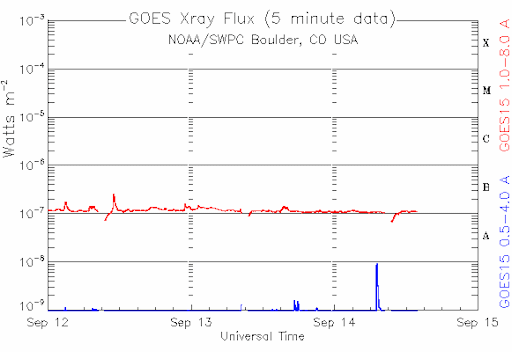 Astro Picture of the Day: September 14, 2013 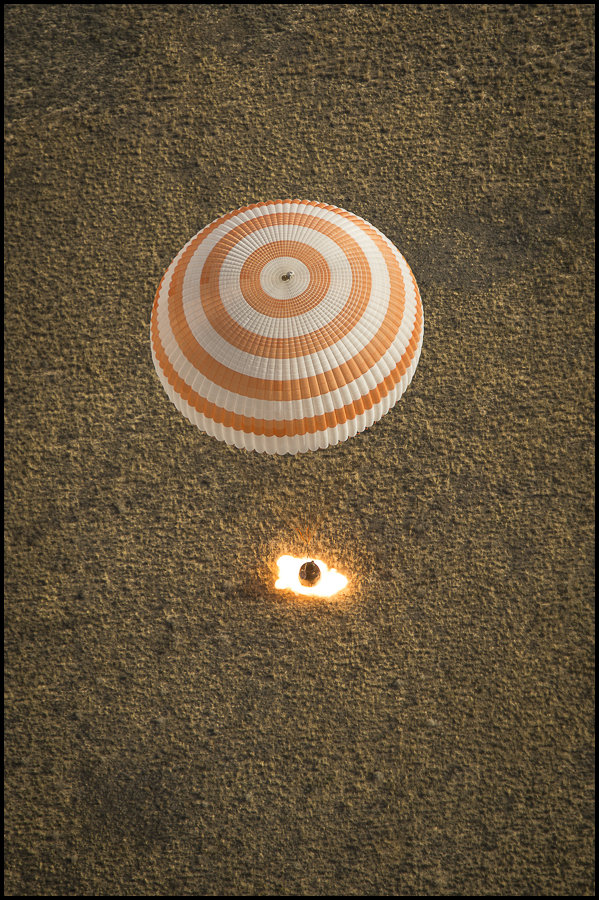 With parachute deployed and retro-rockets blazing, this spacecraft landed on planet Earth on September 11 (UT) in a remote area near the town of Zhezkazgan, Kazakhstan. Seen in silhouette against the rockets' glare, the spacecraft is a Soyuz TMA-08M. Its crew, Expedition 36 Commander Pavel Vinogradov and Flight Engineer Alexander Misurkin of the Russian Federal Space Agency (Roscosmos), and Flight Engineer Chris Cassidy of NASA were returning after five and half months aboard the International Space Station. The Soyuz retro-rockets fire very quickly and for an extremely short duration near touchdown. Capturing the moment, the well-timed photograph was taken from a helicopter flying over the landing site.
__________________
1st in Kommisar's 2009 SM Tournament 1st in I Love You`s 2009 New Year`s Tournament 3rd in EnR's Mashfest '08 tournament 5th in Phynx's Unofficial FFR Tournament 9th in D3 of the 2008-2009 4th Official FFR Tournament 10th in D5 of the 2010 5th Official FFR Tournament 10th in D6 of the 2011-2012 6th Official FFR Tournament FMO AAA Count: 71 FGO AAA Count: 10 Bluearrowll = The Canadian player who can not detect awkward patterns. If it's awkward for most people, it's normal for Terry. If the file is difficult but super straight forward, he has issues. If he's AAAing a FGO but then heard that his favorite Hockey team was losing by a point, Hockey > FFR PS: Cool AAA's Terry - I Love You An Alarm Clock's Haiku beep beep beep beep beep beep beep beep beep beep beep beep beep beep beep beep beep - ieatyourlvllol |
|
|

|
|
|
#673 |
|
⊙▃⊙
|
What's in the sky tonight?
September 15, 2013 -At dusk, look southeast high above the Moon for Altair. Lower in the east, the Great Square of Pegasus balances on one corner. -The quiet from the sun is unlikely to break this weekend. NOAA forecasters estimate a scant 1% chance of M- or X-class solar flares during the next 24-48 hours. The quiet spell is a bit strange because 2013 is supposed to be a year of solar maximum, with lots of flares and sunspots. Supporting this view are data from NASA-supported observatories which show that the sun's magnetic field is poised to flip - a long-held sign that Solar Max has arrived. Nevertheless, solar activity is low. One possible explanation is that Solar Max is double-peaked and we are in the valley between peaks. If so, solar activity could surge again in late 2013-2014. No one can say for sure, though. Researchers have been studying sunspots for more than 400 years, and we still cannot predict the behavior of the solar cycle. Continued quiet or stormy space weather? Both are possible in the weeks and months ahead.  Astro Picture of the Day: September 15, 2013  Are stars better appreciated for their art after they die? Actually, stars usually create their most artistic displays as they die. In the case of low-mass stars like our Sun and M2-9 pictured above, the stars transform themselves from normal stars to white dwarfs by casting off their outer gaseous envelopes. The expended gas frequently forms an impressive display called a planetary nebula that fades gradually over thousand of years. M2-9, a butterfly planetary nebula 2100 light-years away shown in representative colors, has wings that tell a strange but incomplete tale. In the center, two stars orbit inside a gaseous disk 10 times the orbit of Pluto. The expelled envelope of the dying star breaks out from the disk creating the bipolar appearance. Much remains unknown about the physical processes that cause planetary nebulae.
__________________
1st in Kommisar's 2009 SM Tournament 1st in I Love You`s 2009 New Year`s Tournament 3rd in EnR's Mashfest '08 tournament 5th in Phynx's Unofficial FFR Tournament 9th in D3 of the 2008-2009 4th Official FFR Tournament 10th in D5 of the 2010 5th Official FFR Tournament 10th in D6 of the 2011-2012 6th Official FFR Tournament FMO AAA Count: 71 FGO AAA Count: 10 Bluearrowll = The Canadian player who can not detect awkward patterns. If it's awkward for most people, it's normal for Terry. If the file is difficult but super straight forward, he has issues. If he's AAAing a FGO but then heard that his favorite Hockey team was losing by a point, Hockey > FFR PS: Cool AAA's Terry - I Love You An Alarm Clock's Haiku beep beep beep beep beep beep beep beep beep beep beep beep beep beep beep beep beep - ieatyourlvllol |
|
|

|
|
|
#674 |
|
⊙▃⊙
|
What's in the sky tonight?
September 16, 2013 -Low in the western twilight, Saturn is now within 4° of brighter Venus. In a telescope at high power they'll be very blurry though the thick atmosphere, but you can certainly observe their wildly different surface brightnesses. Venus is 13 times closer to the Sun than Saturn is, so it's illuminated by sunlight that's about 169 times as bright! -If you live close to latitude 40° north, Saturn stands straight over Venus on Monday evening. -NOAA forecasters estimate a 45% chance of polar geomagnetic storms on Sept. 16th in response to an incoming solar wind stream.  News Posted Today: September 15, 2013 Hisaki: An Orbiting Planetary Observatory  Astro Picture of the Day: September 16, 2013 No one, presently, sees the Moon rotate like this. That's because the Earth's moon is tidally locked to the Earth, showing us only one side. Given modern digital technology, however, combined with many detailed images returned by the Lunar Reconnaissance Orbiter (LRO), a high resolution virtual Moon rotation movie has now been composed. The above time-lapse video starts with the standard Earth view of the Moon. Quickly, though, Mare Orientale, a large crater with a dark center that is difficult to see from the Earth, rotates into view just below the equator. From an entire lunar month condensed into 24 seconds, the video clearly shows that the Earth side of the Moon contains an abundance of dark lunar maria, while the lunar far side is dominated by bright lunar highlands. Two new missions are scheduled to begin exploring the Moon within the year, the first of which is NASA's Lunar Atmosphere and Dust Environment Explorer (LADEE). LADEE, which launched just over a week ago, is scheduled to begin orbiting the Moon in October and will explore the thin and unusual atmosphere of the Moon. In a few months, the Chinese Chang'e 3 is scheduled to launch, a mission that includes a soft lander that will dispatch a robotic rover.
__________________
1st in Kommisar's 2009 SM Tournament 1st in I Love You`s 2009 New Year`s Tournament 3rd in EnR's Mashfest '08 tournament 5th in Phynx's Unofficial FFR Tournament 9th in D3 of the 2008-2009 4th Official FFR Tournament 10th in D5 of the 2010 5th Official FFR Tournament 10th in D6 of the 2011-2012 6th Official FFR Tournament FMO AAA Count: 71 FGO AAA Count: 10 Bluearrowll = The Canadian player who can not detect awkward patterns. If it's awkward for most people, it's normal for Terry. If the file is difficult but super straight forward, he has issues. If he's AAAing a FGO but then heard that his favorite Hockey team was losing by a point, Hockey > FFR PS: Cool AAA's Terry - I Love You An Alarm Clock's Haiku beep beep beep beep beep beep beep beep beep beep beep beep beep beep beep beep beep - ieatyourlvllol |
|
|

|
|
|
#675 |
|
⊙▃⊙
|
What's in the sky tonight?
September 17, 2013 -This is the time of year when, as the stars come out, bright Arcturus shines due west at the same height as the Big Dipper hangs in the northwest. -The sunspot number has dropped to its lowest level of the year. Solitary sunspot AR1841 sits all alone at the center of an otherwise blank solar disk. It is quiet and poses no threat for strong flares. -NOAA forecasters estimate a scant 1% chance of M- or X-class solar flares during the next 24-48 hours. If the forecast holds, the sun will continue a spate of deep quiet that has lasted for more than a week, nearly-flatlining the sun's x-ray output. 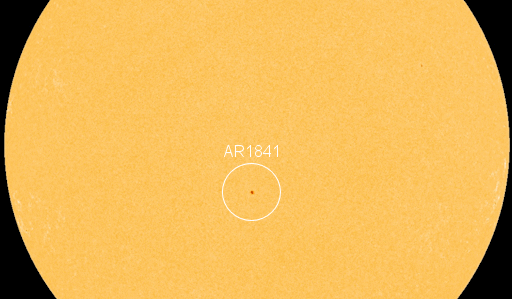 Astro Picture of the Day: September 17, 2013  It is one of the most massive objects in the visible universe. In this view from the Hubble Space Telescope's Advanced Camera for Surveys, Abell 1689 is seen to warp space as predicted by Einstein's theory of gravity - deflecting light from individual galaxies which lie behind the cluster to produce multiple, curved images. The power of this enormous gravitational lens depends on its mass, but the visible matter, in the form of the cluster's yellowish galaxies, only accounts for about one percent of the mass needed to make the observed bluish arcing images of background galaxies. In fact, most of the gravitational mass required to warp space enough to explain this cosmic scale lensing is in the form of still mysterious dark matter. As the dominant source of Abell 1689's gravity, the dark matter's unseen presence is mapped out by the lensed arcs and distorted background galaxy images. Surprisingly, close inspection of the above image has revealed the presence of over 100,000 globular star clusters in the galaxy cluster.
__________________
1st in Kommisar's 2009 SM Tournament 1st in I Love You`s 2009 New Year`s Tournament 3rd in EnR's Mashfest '08 tournament 5th in Phynx's Unofficial FFR Tournament 9th in D3 of the 2008-2009 4th Official FFR Tournament 10th in D5 of the 2010 5th Official FFR Tournament 10th in D6 of the 2011-2012 6th Official FFR Tournament FMO AAA Count: 71 FGO AAA Count: 10 Bluearrowll = The Canadian player who can not detect awkward patterns. If it's awkward for most people, it's normal for Terry. If the file is difficult but super straight forward, he has issues. If he's AAAing a FGO but then heard that his favorite Hockey team was losing by a point, Hockey > FFR PS: Cool AAA's Terry - I Love You An Alarm Clock's Haiku beep beep beep beep beep beep beep beep beep beep beep beep beep beep beep beep beep - ieatyourlvllol |
|
|

|
|
|
#676 |
|
⊙▃⊙
|
What's in the sky tonight?
September 18, 2013 -Full Moon tonight and tomorrow night (exactly full at 7:13 a.m. Thursday morning EDT). The Moon is passing through dim Pisces, to the lower right of the Great Square of Pegasus both evenings. -Tonight's full Moon is the "Harvest Moon," the full Moon closest to the autumnal equinox. Look for it rising in the east at sunset. Swollen by the Moon illusion and reddened by the effect of low-hanging clouds, the rising Harvest moon is often likened to a "Great Pumpkin." -After a week of deep quiet, the drowsy sun seems to be waking up. Five new sunspots were numbered on Sept. 17th as the sun hurled a series of coronal mass ejections (CMEs) into space. The Solar and Heliospheric Observatory recorded the expanding clouds. Earth was not in the line of fire of the CMEs. One of them, however, might deliver a glancing blow to our planet's magnetic field a few days hence. 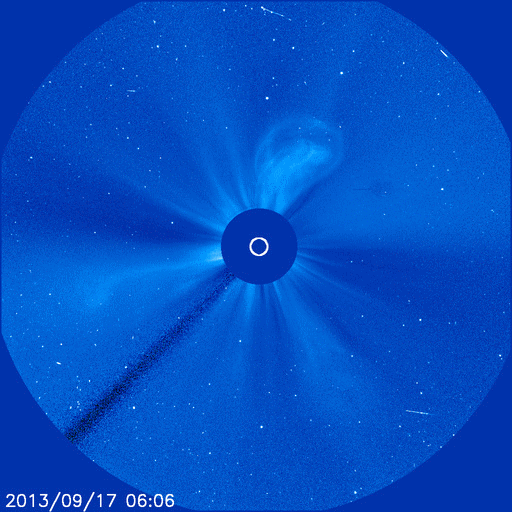 Astro Picture of the Day: September 18, 2013 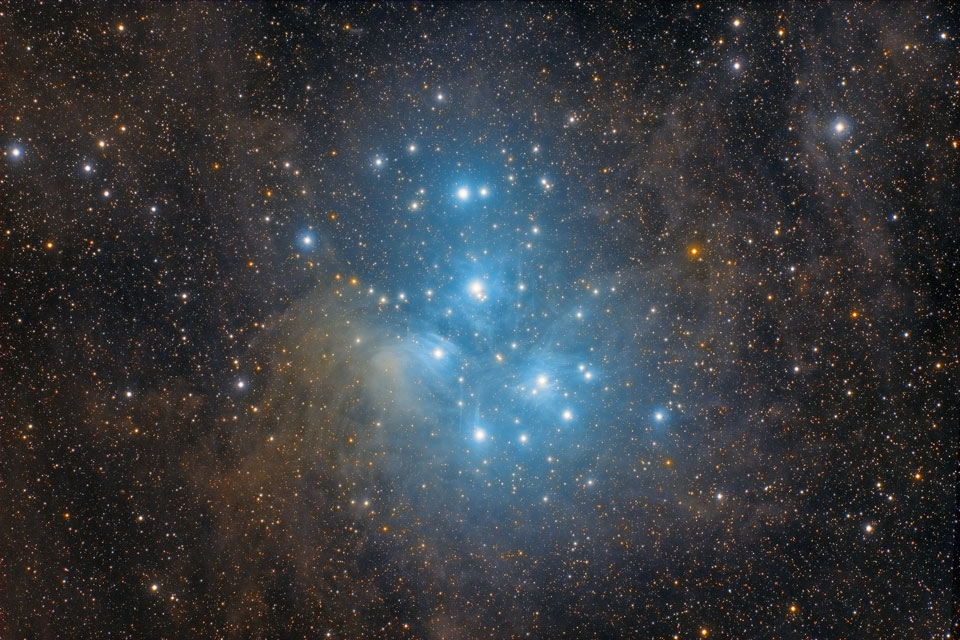 Have you ever seen the Pleiades star cluster? Even if you have, you probably have never seen it as dusty as this. Perhaps the most famous star cluster on the sky, the bright stars of the Pleiades can be seen without binoculars from even the depths of a light-polluted city. With a long exposure from a dark location, though, the dust cloud surrounding the Pleiades star cluster becomes very evident. The above exposure took about 30 hours and covers a sky area several times the size of the full moon. Also known as the Seven Sisters and M45, the Pleiades lies about 400 light years away toward the constellation of the Bull (Taurus). A common legend with a modern twist is that one of the brighter stars faded since the cluster was named, leaving only six stars visible to the unaided eye. The actual number of Pleiades stars visible, however, may be more or less than seven, depending on the darkness of the surrounding sky and the clarity of the observer's eyesight.
__________________
1st in Kommisar's 2009 SM Tournament 1st in I Love You`s 2009 New Year`s Tournament 3rd in EnR's Mashfest '08 tournament 5th in Phynx's Unofficial FFR Tournament 9th in D3 of the 2008-2009 4th Official FFR Tournament 10th in D5 of the 2010 5th Official FFR Tournament 10th in D6 of the 2011-2012 6th Official FFR Tournament FMO AAA Count: 71 FGO AAA Count: 10 Bluearrowll = The Canadian player who can not detect awkward patterns. If it's awkward for most people, it's normal for Terry. If the file is difficult but super straight forward, he has issues. If he's AAAing a FGO but then heard that his favorite Hockey team was losing by a point, Hockey > FFR PS: Cool AAA's Terry - I Love You An Alarm Clock's Haiku beep beep beep beep beep beep beep beep beep beep beep beep beep beep beep beep beep - ieatyourlvllol |
|
|

|
|
|
#677 |
|
⊙▃⊙
|
What's in the sky tonight?
September 19, 2013 -A winter preview: If you're up before dawn this week, the southern sky displays the same starry panorama as it will at dusk next February. Orion stands high in the south, Sirius and Canis Major sparkle to its lower left, and Gemini, with Jupiter, occupies the high east. Come February, Jupiter will still be there. -Comet ISON is still more than two months away from its spectacular close encounter with the sun. Amateur astronomers aren't waiting. Observers of Comet ISON will notice that it is in the same part of the sky as Mars. The comet will make a close approach to the Red Planet on October 1st, and during that time Mars satellites will be taking ISON's picture at point blank range. Those images will likely rival or improve upon the view from Earth. Comet ISON is currently not a naked eye object, but Up to date pictures of Comet ISON can be found here: http://spaceweather.com/gallery/inde...et&title2=ison Astro Picture of the Day: September 19, 2013 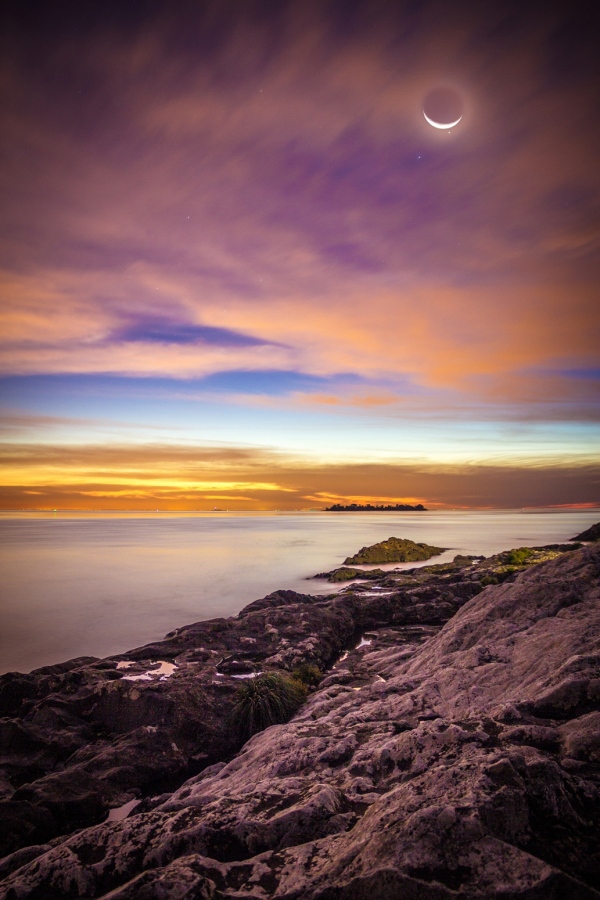 In this engaging scene from planet Earth, the Moon shines through cloudy skies following sunset on the evening of September 8. Despite the fading light, the camera's long exposure still recorded a colorful, detailed view of a shoreline and western horizon looking toward the island San Gabriel from Colonia del Sacramento, Uruguay. Lights from Buenos Aires, Argentina are along the horizon on the left, across the broad Rio de la Plata estuary. The long exposure strongly overexposed the Moon and sky around it, though. So the photographer quickly snapped a shorter one to merge with the first image in the area around the bright lunar disk. As the the second image was made with a telephoto setting, the digital merger captures both Earth and sky, exaggerating the young Moon's slender crescent shape in relation to the two nearby bright stars. The more distant is bluish Spica, alpha star of the constellation Virgo. Closest to the Moon is Earth's evening star, planet Venus, emerging from a lunar occultation.
__________________
1st in Kommisar's 2009 SM Tournament 1st in I Love You`s 2009 New Year`s Tournament 3rd in EnR's Mashfest '08 tournament 5th in Phynx's Unofficial FFR Tournament 9th in D3 of the 2008-2009 4th Official FFR Tournament 10th in D5 of the 2010 5th Official FFR Tournament 10th in D6 of the 2011-2012 6th Official FFR Tournament FMO AAA Count: 71 FGO AAA Count: 10 Bluearrowll = The Canadian player who can not detect awkward patterns. If it's awkward for most people, it's normal for Terry. If the file is difficult but super straight forward, he has issues. If he's AAAing a FGO but then heard that his favorite Hockey team was losing by a point, Hockey > FFR PS: Cool AAA's Terry - I Love You An Alarm Clock's Haiku beep beep beep beep beep beep beep beep beep beep beep beep beep beep beep beep beep - ieatyourlvllol |
|
|

|
|
|
#678 |
|
⊙▃⊙
|
What's in the sky tonight?
September 20, 2013 -Saturn is still 4° to the upper right of bright Venus in twilight, as shown here. Watch it move farther from Venus each evening. -As summer nears its end, orange Antares blinks its bleary seasonal farewell low in the southwest after dusk. The farther north you are, the sooner Antares sinks out of sight.  Astro Picture of the Day: September 20, 2013  Colorful stars trail through this late summer, night skyscape from Cape Cod, Massachusetts. The picture was composed by stacking 12 consecutive 1 minute long digital camera exposures to follow the trails, a reflection of our fair planet's daily rotation. It also records faint clouds of the Milky Way in the clear sky, stretching above a local drive-in movie theater. In fact, watching movies from cars at the drive-in was once a more common night time activity. But while the stars still shine, drive-in theaters have faded from the American landscape over the decades since the 1950s. Still, this recent scene includes a short exposure made as the projector beamed a space age image to the movie screen, and drive-in skygazers watched a view of the Earth below the International Space Station, under the stars above.
__________________
1st in Kommisar's 2009 SM Tournament 1st in I Love You`s 2009 New Year`s Tournament 3rd in EnR's Mashfest '08 tournament 5th in Phynx's Unofficial FFR Tournament 9th in D3 of the 2008-2009 4th Official FFR Tournament 10th in D5 of the 2010 5th Official FFR Tournament 10th in D6 of the 2011-2012 6th Official FFR Tournament FMO AAA Count: 71 FGO AAA Count: 10 Bluearrowll = The Canadian player who can not detect awkward patterns. If it's awkward for most people, it's normal for Terry. If the file is difficult but super straight forward, he has issues. If he's AAAing a FGO but then heard that his favorite Hockey team was losing by a point, Hockey > FFR PS: Cool AAA's Terry - I Love You An Alarm Clock's Haiku beep beep beep beep beep beep beep beep beep beep beep beep beep beep beep beep beep - ieatyourlvllol |
|
|

|
|
|
#679 |
|
⊙▃⊙
|
What's in the sky tonight?
September 21, 2013 -After the last of twilight has faded away, the Northern Cross in Cygnus floats near the zenith (for skywatchers at mid-northern latitudes). Without looking: Do you know which way its long end points? If you guessed southwest, you're right. -The September equinox occurs at 4:44 p.m. EDT (20:44 UT) on Sunday, Sept. 22nd, when the Sun crosses the equator heading south. This marks the beginning of autumn in the northern hemisphere and spring in the southern hemisphere. On this date, day and night are of approximately equal length. You know the equinox is near when you find yourself nearly-blinded while driving down east-west roads. Alan Friedman demonstrates the phenomenon from his hometown in Buffalo, New York. "At the equinoxes, the sun rises due east and sets due west on my street in Buffalo," says Friedman. "One has to drive carefully!" 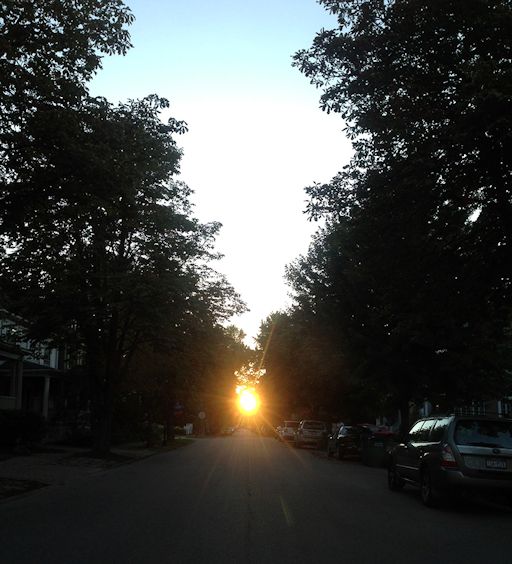 Astro Picture of the Day: September 21, 2013  The sky looks dark in this scene from the Mid-Atlantic Regional Spaceport (MARS) at NASA Wallops Flight Facility, Virginia. Captured on Wednesday, September 18, an Orbital Sciences Corporation Antares rocket is leaving launch pad-0A with the Cygnus cargo spacecraft aboard. Though it looks like night, the photograph was taken at 10:58am EDT, under bright, clear morning skies, with a digital camera modified to record infrared images. The Sun itself is above and left of the picture frame, creating strong glare and internal reflections in the camera lens at near-infrared wavelengths. In the false-color presentation, the vegetation and watery reflections also take on an otherworldly pallor. Reaching orbit, the Cygnus spacecraft is now on its way to a Sunday rendezvous with the International Space Station. The spacecraft will deliver about 1,300 pounds (589 kilograms) of cargo to the Expedition 37 crew.
__________________
1st in Kommisar's 2009 SM Tournament 1st in I Love You`s 2009 New Year`s Tournament 3rd in EnR's Mashfest '08 tournament 5th in Phynx's Unofficial FFR Tournament 9th in D3 of the 2008-2009 4th Official FFR Tournament 10th in D5 of the 2010 5th Official FFR Tournament 10th in D6 of the 2011-2012 6th Official FFR Tournament FMO AAA Count: 71 FGO AAA Count: 10 Bluearrowll = The Canadian player who can not detect awkward patterns. If it's awkward for most people, it's normal for Terry. If the file is difficult but super straight forward, he has issues. If he's AAAing a FGO but then heard that his favorite Hockey team was losing by a point, Hockey > FFR PS: Cool AAA's Terry - I Love You An Alarm Clock's Haiku beep beep beep beep beep beep beep beep beep beep beep beep beep beep beep beep beep - ieatyourlvllol |
|
|

|
|
|
#680 | |
|
"Reach For The Stars"
|
Last night and the night before we watched the Harvest Moon. Boy was it bright!!
__________________
Quote:
 |
|
|
|

|
 |
| Currently Active Users Viewing This Thread: 1 (0 members and 1 guests) | |
|
|